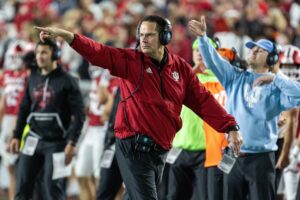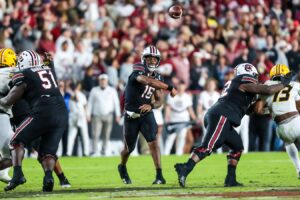Takeaways from an Opening Loss
OK, Mountaineer fans, let us talk candidly about this past weekend. A Week 1 loss does not signal the end of the world. As we wrote in our preview (in which we admit we got a lot wrong), we observed that Maryland has had some big opening week wins of late, and against good teams, too. They are now 4-0 in their non-conference Power Five openers in the last four years. That includes a road win against Texas, a home win against Texas (when the Longhorns finished 10-4), and a home win against Syracuse. Now, it includes a home win against the West Virginia Mountaineers. By itself, the result is not the end of the world. That said, we want to take a deeper look into the how. As a result, we recap our takeaways from an opening loss.
Where Were The Takeaways?
First and foremost, let us point out the irony of our title. We are looking at takeaways from an opening loss. Yet West Virginia had actual zero takeaways through the game. Zero. This is against a Maryland team that coughed the ball up more than two times per game last season. They had exactly one game last season with zero turnovers (their win against Penn State).
The Mountaineers did not exactly light the world on fire with takeaways last season. That said, they took away the ball at least once in eight of 10 games. The only games where they had zero takeaways were both losses, to Texas and Iowa State. As Head Coach Neal Brown said in his post-game remarks: it’s really simple, if you do not turn the ball over, you have a good chance of winning the game. When you cough up the ball four times and have zero takeaways to match, the team has virtually no chance of winning.
While the defense played very well after settling in late in the first quarter (at least until they found themselves worn out late in the fourth quarter), they have to focus on getting takeaways.
So, About That Offensive Line
The offensive line received a complete makeover during the last two off-seasons. Maybe, just maybe, we chalk up last Saturday’s performance to first-game jitters. The unit essentially returned three, in Zach Frazier, Brandon Yates, and James Gmiter. For the most part, those three held their own.
They also rotated three “new” bodies in Parker Moorer, Doug Nester, and Wyatt Milum. Nester had a few series where he lost his footing, surrendering at least one sack and a hurry-up. We are confident, however, that he will return to All-Conference form soon enough. Moorer started off with a few bumps, and the staff turned to Milum, who looked like the true freshman he is. After his return, Moorer looked much better.
Overall, though, the offensive line needs work. Brown did not test its line often in the run (more in a moment), but in pass protection, it failed just 28.9% of the time. Keenan Cummings at WVSports unveiled this stat on Sunday. The offensive line kept Jarrett Doege‘s pocket clean on 71.1 percent of the team’s passing plays. In raw numbers, Doege saw a clean pocket on 32 out of 45 pass plays.
This number is not terrible. Historically-good offensive lines still surrender pressure about 22% of the time. The average hovers around 30%. Essentially, the unit turned in an “average” level performance against Maryland. While an improvement over the last two seasons, this remains an area that must be improved, as the line has the raw talent to at least be a good (not just average) unit. Given our quarterback play under pressure (see more below), our offensive success hinges on it.
Calling All Running Backs
Here, we throw in two takeaways from an opening loss in one. Reviewing the snap counts after the game affirmed our own observations during the game: Leddie Brown was always on the field. OK, maybe “always” is an exaggeration, but it’s only slight. The only other running back to tally any snaps in this game other than Brown was Justin Johnson, who logged one single snap.
We understand that Tony Mathis dealt with an injury that kept him out. We also understand that A’varius Sparrow remains raw. Finally, we understand that Justin Johnson is just a true freshman. In a close game against a regional rival to open the season, that is not exactly the best time to start testing out unproven talent. That said, Coach Brown made it a priority to use his depth to keep Brown’s wheels fresh later in the game. The offense snapped the ball 65 times. Brown saw action on all but one.
Particularly when the offense could not manage much of anything in the third quarter, it would have been a perfect time to try and rejuvenate some of those doing the heaviest lifting. Brown, after all, punched in all three of the Mountaineers’ scores last weekend. This trend, simply, cannot continue.
Where Was The Run?
While we are on the subject, we also scratched our heads on the pass-run breakdown. In the first two drives, the Mountaineers passed the ball 11 times and ran the ball twice. Through the first half, they only ran the ball 11 total times for 48 yards. While the yards per carry (just under four-and-a-half) was not exemplary, it was certainly enough to justify more looks. This is particularly true considering Maryland’s run defense was its single greatest weakness last season.
The ills of relying so heavily on the pass reared their ugly head several times last season. And it was also apparent Saturday. To start the half with a 21-20 lead, the Mountaineers’ first drive featured all passes and no runs. The results? Doege went 1-3 for 15 yards and took a sack.
Then, when the Mountaineers went down 23-21, Winston Wright helped the offense with a fantastic kick return followed by a quick-strike 39-yard pass to Sam James. In the red zone with three timeouts, and what do we do? Doege throws an incompletion, then he throws a fade into the corner of the end zone that was intercepted. To be fair, the play represented an odd outcome because it resulted from truly broken coverage. A corner left his receiver wide open at the moment Doege released the ball. Was it a designed read? Perhaps.
Regardless how we assign blame on that play, why don’t we rely on our workhorse back inside the red zone? Even if three straight runs go for no gain (unlikely), Casey Legg still comes in for a 30-yard field goal to take the lead late in the fourth quarter. It gives the defense a longer rest, too. It’s not like the unit had been performing poorly in the second half, either. Maryland converted for just three points on the prior four drives, totaling just 79 yards in a quarter-and-a-half.
What Would Doege Do?
During the media sessions during the Spring, Coach Brown started pitching a story to all who would listen. Doege, he said, was charting a course to be the most improved player on the entire team. Doege knew what he needed to work on, and he was doing it. Initially, we doubted it very much. In fact, we wrote in our Spring position preview that we needed to see a younger quarterback step up.
We had very specific reasons for saying so. Doege had started games in four straight seasons. With around 2,000 Division I snaps of experience, we said that it would be highly unusual for a quarterback to radically improve his game between season four and five as full- or part-time starter.
But Brown and the entire staff, including the defensive staff, repeated the phrase so much that we started to believe it. So far, we feel we should have stuck to our initial instinct: Doege is who Doege is. He has reached his ceiling, and we know what that is.
He still has trouble dealing with a collapsing pocket and finding his way out of pressure. As we noted above, Doege faced pressure 13 times. In those play, he suffered three sacks, and he took an intentional grounding penalty tantamount to a fourth sack. On the other nine plays, he completed three passes (33% completion percentage) for just 30 yards and an interception on one of the worst decisions he has made in the Old Gold and Blue. (He also called a time out when he had none remaining.)
Also as we said above, even the best offensive lines let pressure through more than 20% of the time. The ability to handle pressure indeed represents one of the advanced metrics NFL scouts love to use, for good reason. Pressure is a part of life as quarterback.
The Quest for Answers
Again, we have just one game behind us. We recognize that it is easy to Monday-morning quarterback a game. We know the coaches and the players work hard to put a good product on the field. Despite our focus on the negatives in our takeaways from an opening loss, we have the utmost respect for what the coaches and players do.
That said, we would not be doing our job if we did not point out what we saw. We expect the staff is seeing many of the same things. The game, after all, is not rocket science. Broken down into its component parts, it is actually fairly simple. But what we saw on Saturday represented generally poor execution in multiple facets. How quickly we see improvement (and how much) will ultimately determine how successful the Mountaineers can be this season.
[pickup_prop id=”8844″]






